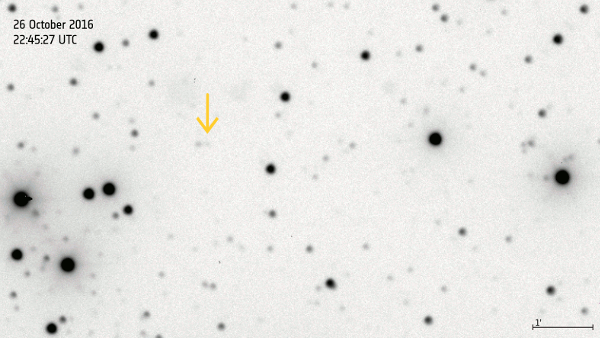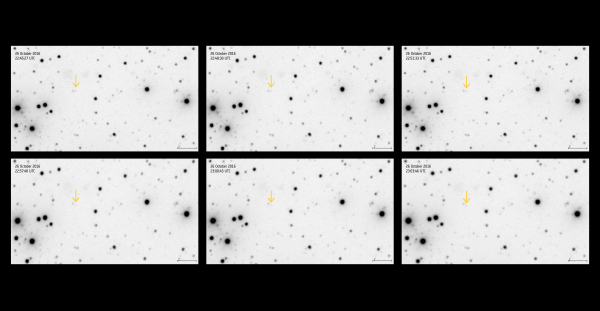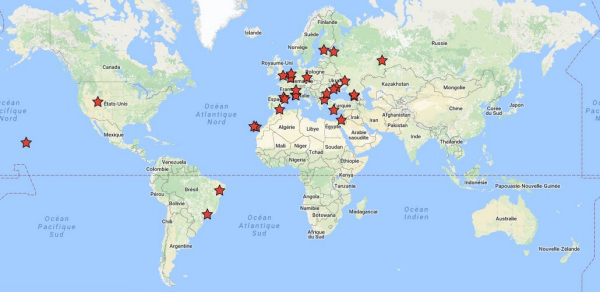Gaia turns its eyes to asteroid hunting
24 January 2017
Whilst best known for its surveys of the stars and mapping the Milky Way in three dimensions, ESA's Gaia has many more strings to its bow. Among them, its contribution to our understanding of the asteroids that litter the Solar System. Now, for the first time, Gaia is not only providing information crucial to understanding known asteroids, it has also started to look for new ones, previously unknown to astronomers.Since it began scientific operations in 2014, Gaia has played an important role in understanding Solar System objects. This was never the main goal of Gaia – which is mapping about a billion stars, roughly 1% of the stellar population of our Galaxy – but it is a valuable side effect of its work. Gaia's observations of known asteroids have already provided data used to characterise the orbits and physical properties of these rocky bodies more precisely than ever before.
"All of the asteroids we studied up until now were already known to the astronomy community," explains Paolo Tanga, Planetary Scientist at Observatoire de la Côte d'Azur, France, responsible for the processing of Solar System observations.
These asteroids were identified as spots in the Gaia data that were present in one image and gone in one taken a short time later, suggesting they were in fact objects moving against the more distant stars.
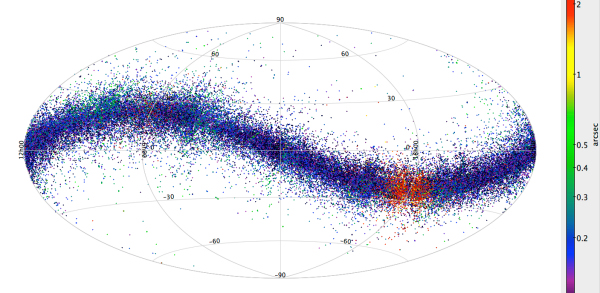 |
| Gaia's asteroid detections. ESA/Gaia/DPAC/CU4, L. Galluccio, F. Mignard, P. Tanga (Observatoire de la Côte d'Azur) |
Once identified, moving objects found in the Gaia data are matched against known asteroid orbits to tell us which asteroid we are looking at. "Now," continues Tanga, "for the first time, we are finding moving objects that can't be matched to any catalogued star or asteroid."
The process of identifying asteroids in the Gaia data begins with a piece of code known as the Initial Data Processing (IDT) software – which was largely developed at the University of Barcelona and runs at the Data Processing Centre at the European Space Astronomy Centre (ESAC), ESA's establishment in Spain.
This software compares multiple measurements taken of the same area and singles out objects that are observed but cannot be found in previous observations of the area. These are likely not to be stars but, instead, Solar System objects moving across Gaia's field of view. Once found, the outliers are processed by a software pipeline at the Centre National d'Etudes Spatiales (CNES) data centre in Toulouse, France, which is dedicated to Solar System objects. Here, the source is cross matched with all known minor bodies in the Solar System and if no match is found, then the source is either an entirely new asteroid, or one that has only been glimpsed before and has never had its orbit accurately characterised.
Although tests have shown Gaia is very good at identifying asteroids, there have so far been significant barriers to discovering new ones. There are areas of the sky so crowded that it makes the IDT's job of matching observations of the same star very difficult. When it fails to do so, large numbers of mismatches end up in the Solar System objects pipeline, contaminating the data with false asteroids and making it very difficult to discover new ones.
"At the beginning, we were disappointed when we saw how cluttered the data were with mismatches," explains Benoit Carry, Observatoire de la Côte d'Azur, France, who is in charge of selecting Gaia alert candidates. "But we have come up with ways to filter out these mismatches and they are working! Gaia has now found an asteroid barely observed before."
The asteroid in question, nicknamed Gaia-606, was found in October 2016 when Gaia data showed a faint, moving source. Astronomers immediately got to work and were able to predict the new asteroid's position as seen from the ground over a period of a few days. Then, at the Observatoire de Haute Provence (southern France), William Thuillot and his colleagues Vincent Robert and Nicolas Thouvenin (Observatoire de Paris/IMCCE) were able to point a telescope at the positions predicted and show this was indeed an asteroid that did not match the orbit of any previously catalogued Solar System object.
However, despite not being present in any catalogue, a more detailed mapping of the new orbit has shown that some sparse observations of the object do already exist. This is not uncommon with new discoveries where, as with Gaia-606 (now renamed 2016 UV56), objects that first appear entirely new transpire to be re-sightings of objects whose previous observations were not sufficient to map their orbits.
"This really was an asteroid not present in any catalogue, and that is an exciting find!" explains Thuillot. "So whilst we can't claim this is the first true asteroid discovery from Gaia, it is clearly very close and shows how near we are to finding a never-before-seen Solar System object with Gaia."
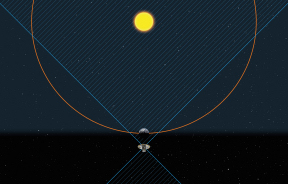 |
| Asteroid search region. Credit: ESA |
Gaia-606 was found in the main asteroid belt, which is not surprising given how many asteroids exist there. However, Gaia also provides data from swathes of the sky not extensively observed by existing ground-based surveys giving it the potential to find asteroids in areas where others would not look. One such area is a region close to the Sun as seen from Earth. Observations are made from the Earth during the night when the angle between any source and the Sun is fairly large, whilst Gaia can make observations at any time and so observe objects much closer to the Sun. This gives Gaia the exciting potential to observe asteroids that orbit within Earth's orbit – these are known as Atira asteroids and only sixteen are currently known.
Gaia also has the potential to make discoveries at high ecliptic latitudes. Not because ground-based surveys of Solar System objects cannot observe there, but because they tend not to. The vast majority of asteroids exist in the ecliptic plane and, as a result, it is here that most surveys concentrate their efforts. Gaia has no such prejudices and scans the entire sky, giving it the potential to discover new asteroids in the less crowded areas missed by other surveys.
"Whilst Gaia's primary role in Solar System science remains its ability to characterise the movement and physical properties of known asteroids, it has now shown that it can also play a role in finding new ones, adding to its ever expanding catalogue of Solar System objects," concludes Tanga.
About Gaia
Gaia is an ESA mission to survey one billion stars in our Galaxy and local galactic neighbourhood in order to build the most precise 3D map of the Milky Way and answer questions about its origin and evolution.
The mission's primary scientific product will be a catalogue with the positions, motions, brightnesses, and colours of the more than a billion surveyed stars. The first intermediate catalogue was released in September 2016. In the meantime, Gaia's observing strategy, with repeated scans of the entire sky, is allowing the discovery and measurement of many transient events across the sky: among these are the detection of candidate asteroids which are subsequently observed by astronomers in the Gaia Follow-Up-Network. During the five-year nominal mission, Gaia is expected to observe about 350 000 asteroids of which a few thousand will be previously unknown.
The nature of the Gaia mission leads to the acquisition of an enormous quantity of complex, extremely precise data, and the data-processing challenge is a huge task in terms of expertise, effort and dedicated computing power. A large pan-European team of expert scientists and software developers, the Data Processing and Analysis Consortium (DPAC), located in and funded by many ESA member states, and with contributions from ESA, is responsible for the processing and validation of Gaia's data, with the final objective of producing the Gaia Catalogue. Scientific exploitation of the data only takes place once the data are openly released to the community.
Contacts
Paolo Tanga
Observatoire de la Côte d'Azur, France
Email: Paolo.Tanga![]() oca.eu
oca.eu
Benoit Carry
Observatoire de la Côte d'Azur, France
Email: benoit.carry![]() oca.eu
oca.eu
William Thuillot
Observatoire de Paris, France
Email: William.Thuillot![]() obspm.fr
obspm.fr
Timo Prusti
Gaia Project Scientist
Directorate of Science
European Space Agency
Email: timo.prusti![]() esa.int
esa.int

